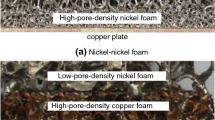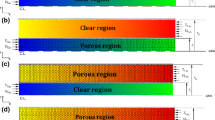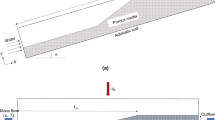Abstract
Porous media are very useful tools used for energy management. They are used in vast fields such as in solar heat exchangers to enhance heat transfer for building applications or in electronic equipment to facilitate heat removal from hot elements. This work presents a numerical study on the potential of using multi-layered porous covers to cool discrete solid blocks positioned inside in a two-dimensional channel. In the first step, four porous covers with three layers, including Case A (all layers with maximum permeability), Case B (all layers with minimum permeability), Case C (increasing permeability as going to the outside of porous cover), and Case D (decreasing permeability as going to the outside of the porous cover). The configurations are inspected in three Reynolds numbers, including Re = 500, 1000, 1500. The results show that Case A and Case D have better performances as compared to other cases. Case D guides the flow around the first block, located at the upstream, and improves heat transfer, especially at higher Reynolds numbers. Finally, a new case based on Case D and Case A is proposed. This case has 6% and 10% better overall heat transfer than Case A at Re = 1000 and Re = 1500, respectively. As well as, the Nusselt number of Case E is about 180% at Re = 500, 220% at Re = 1000, and 250% greater than the base case where porous cover is not used.












Similar content being viewed by others
Abbreviations
- Da:
-
Darcy number
- C p :
-
Specific heat at constant pressure (J kg−1 K−1)
- F :
-
Forchheimer coefficient
- g :
-
Gravitational acceleration (m s−2)
- h :
-
Heat transfer coefficient (W m−2 K)
- H :
-
Channel height (m)
- k :
-
Thermal conductivity (W m−1 K−1)
- K :
-
Permeability (m2)
- Nu:
-
Nusselt number
- p :
-
Pressure (Pa)
- Pr:
-
Prandtl number
- q :
-
Heat flux (W m−2)
- T :
-
Temperature (K)
- u, v :
-
Local velocity components (m s−1)
- x, y :
-
Cartesian coordinates (m)
- ε :
-
Porosity
- θ :
-
Nondimensional temperature
- μ :
-
Dynamic viscosity (Pa s)
- ρ :
-
Fluid density (kg m−3)
- eff:
-
Effective
- f:
-
Fluid
- in:
-
Inlet
- s:
-
Solid
- w:
-
Wall
References
Rashidi S, Esfahani JA, Karimi N. Porous materials in building energy technologies—a review of the applications, modelling and experiments. Renew Sustain Energy Rev. 2018;91:229–47.
Bayrak F, Oztop HF, Hepbasli A. Energy and exergy analyses of porous baffles inserted solar air heaters for building applications. Energy Build. 2013;57:338–45.
Chen W. Thermal analysis on the cooling performance of a wet porous evaporative plate for building. Energy Convers Manag. 2011;52:2217–26.
Khanafer K, Vafai K. Applications of nanofluids in porous medium. J Therm Anal Calorim. 2019;135:1479–92.
Akbarzadeh M, Rashidi S, Karimi N, Omar N. First and second laws of thermodynamics analysis of nanofluid flow inside a heat exchanger duct with wavy walls and a porous insert. J Therm Anal Calorim. 2019;135:177–94.
Miri Joibary SM, Siavashi M. Effect of Reynolds asymmetry and use of porous media in the counterflow double-pipe heat exchanger for passive heat transfer enhancement. J Therm Anal Calorim. 2019. https://doi.org/10.1007/s10973-019-08991-2.
Siavashi M, Miri Joibary SM. Numerical performance analysis of a counter-flow double-pipe heat exchanger with using nanofluid and both sides partly filled with porous media. J Therm Anal Calorim. 2019;135:1595–610.
Yuan Y, Xu K, Zhao K. Numerical analysis of transport in porous media to reduce aerodynamic noise past a circular cylinder by application of porous foam. J Therm Anal Calorim. 2019. https://doi.org/10.1007/s10973-019-08619-5.
Yang Y-T, Hwang M-L. Numerical simulation of turbulent fluid flow and heat transfer characteristics in a rectangular porous channel with periodically spaced heated blocks. Num Heat Transf Part A Appl. 2008;54:819–36.
Yucel N, Guven RT. Numerical study of heat transfer in a rectangular channel with porous covering obstacles. Transp Porous Media. 2009;77:41–58.
Hung T-C, Huang Y-X, Yan W-M. Thermal performance analysis of porous-microchannel heat sinks with different configuration designs. Int J Heat Mass Transf. 2013;66:235–43.
Ismael MA. Forced convection in partially compliant channel with two alternated baffles. Int J Heat Mass Transf. 2019;142:118455.
Haghighi A, Albojamal A, Vafai K. Heat removal enhancement in a channel with a single or an array of metallic foam obstacles. Int J Therm Sci. 2019;149:106057.
Huang PC, Vafai K. Analysis of forced convection enhancement in a channel using porous blocks. J Thermophys Heat Transf. 1994;8:563–73.
Hamadouche A, Azzi A, Abboudi S, Nebbali R. Enhancement of heat exchanger thermal hydraulic performance using aluminum foam. Exp Therm Fluid Sci. 2018;92:1–12.
Akbarzadeh M, Rashidi S, Keshmiri A, Shokri N. The optimum position of porous insert for a double-pipe heat exchanger based on entropy generation and thermal analysis. J Therm Anal Calorim. 2020;139:411–26.
Siavashi M, Bahrami HRT, Saffari H. Numerical investigation of porous rib arrangement on heat transfer and entropy generation of nanofluid flow in an annulus using a two-phase mixture model. Numer Heat Transf Part A Appl. 2017;71:1251–73.
Siavashi M, Talesh Bahrami HR, Saffari H. Numerical investigation of flow characteristics, heat transfer and entropy generation of nanofluid flow inside an annular pipe partially or completely filled with porous media using two-phase mixture model. Energy. 2015;93:2451–66.
Menni Y, Azzi A, Chamkha A. Enhancement of convective heat transfer in smooth air channels with wall-mounted obstacles in the flow path. J Therm Anal Calorim. 2019;135:1951–76.
Zhao Z. Numerical modeling and simulation of heat transfer and fluid flow in a two-dimensional sudden expansion model using porous insert behind that. J Therm Anal Calorim. 2020. https://doi.org/10.1007/s10973-020-09505-1.
Ghasemi K, Siavashi M. MHD nanofluid free convection and entropy generation in porous enclosures with different conductivity ratios. J Magn Magn Mater. 2017;442:474–90.
Siavashi M, Rasam H, Izadi A. Similarity solution of air and nanofluid im**ement cooling of a cylindrical porous heat sink. J Therm Anal Calorim. 2019;135:1399–415.
Siavashi M, Bahrami HRT, Aminian E. Optimization of heat transfer enhancement and pum** power of a heat exchanger tube using nanofluid with gradient and multi-layered porous foams. Appl Therm Eng. 2018;138:465–74.
Wang B, Hong Y, Wang L, Fang X, Wang P, Xu Z. Development and numerical investigation of novel gradient-porous heat sinks. Energy Convers Manag. 2015;106:1370–8.
Wang B, Hong Y, Hou X, Xu Z, Wang P, Fang X, et al. Numerical configuration design and investigation of heat transfer enhancement in pipes filled with gradient porous materials. Energy Convers Manag. 2015;105:206–15.
Maghsoudi P, Siavashi M. Application of nanofluid and optimization of pore size arrangement of heterogeneous porous media to enhance mixed convection inside a two-sided lid-driven cavity. J Therm Anal Calorim. 2019;135:947–61.
Asiaei S, Zadehkafi A, Siavashi M. Multi-layered porous foam effects on heat transfer and entropy generation of nanofluid mixed convection inside a two-sided lid-driven enclosure with internal heating. Transp Porous Med. 2019;126:223–47.
Young TJ, Vafai K. Convective cooling of a heated obstacle in a channel. Int J Heat Mass Transf. 1998;41:3131–48.
Acknowledgements
The study was supported by the China National Key R&D Program (Grant No. 2018YFC0704400).
Author information
Authors and Affiliations
Corresponding author
Additional information
Publisher's Note
Springer Nature remains neutral with regard to jurisdictional claims in published maps and institutional affiliations.
Rights and permissions
About this article
Cite this article
Qi, B., Yuan, R. Heat transfer enhancement in a two-dimensional channel with perforated rectangular blocks using multi-layered porous foam. J Therm Anal Calorim 141, 1817–1827 (2020). https://doi.org/10.1007/s10973-020-09620-z
Received:
Accepted:
Published:
Issue Date:
DOI: https://doi.org/10.1007/s10973-020-09620-z




